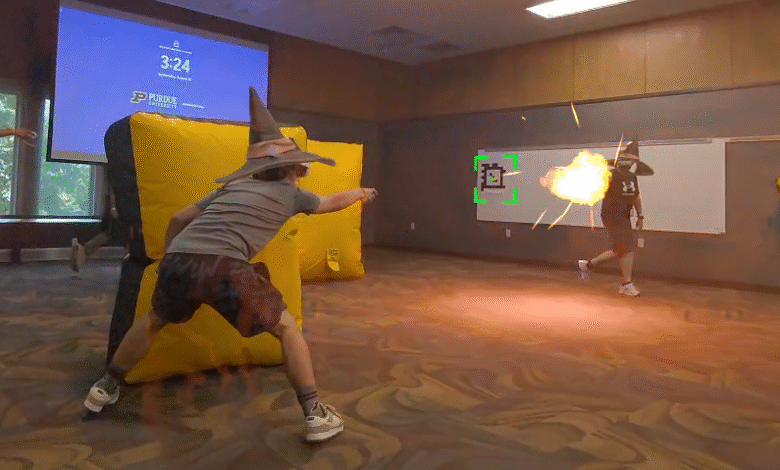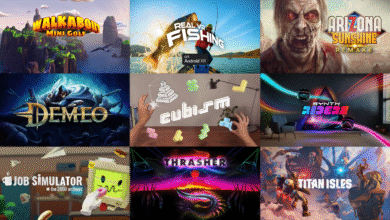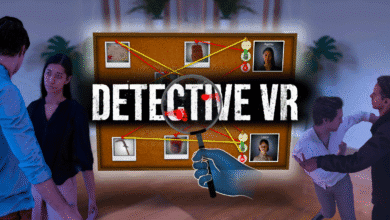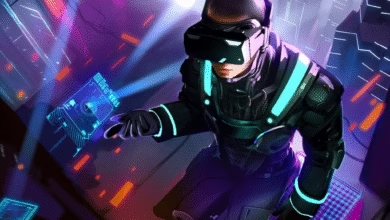Wizardtag: Spellcasting Laser Tag for the Quest 3

▼ Summary
– Wizardtag is a spellcasting version of the multiplayer Quest 3 mixed reality game Lasertag, replacing laserguns with voice-activated wands.
– It uses continuous scene meshing on Quest 3 & 3S to eliminate Meta’s room scanning process, avoiding setup issues and static furniture data.
– Players cast spells by shouting “Fireball,” “Lightning,” or “Shield,” with low-latency detection via the Vosk speech recognition model.
– Triveri developed Wizardtag for a Purdue University event, themed as a magic dueling class in a Harry-Potter-esque setting for freshman orientation.
– Instead of Meta’s Shared Spatial Anchors, Triveri used AprilTags and passthrough camera access for reliable colocation, with plans to eventually release it on the Meta Horizon Store.
Wizardtag transforms the Quest 3 into a magical battlefield, blending spellcasting with mixed reality for a truly immersive multiplayer experience. This innovative game is a creative fork of the frictionless colocated multiplayer shooter Lasertag, developed by Julian Triveri. Instead of using traditional laser guns, players wield voice-activated wands, shouting commands to unleash magical attacks.
The foundation for this magical duel stems from Triveri’s earlier work on Lasertag. Back in May, his project gained attention for a significant technical achievement: implementing continuous scene meshing on the Quest 3 and 3S. This clever innovation bypasses Meta’s official room scanning process entirely. The standard setup requires scanning a room beforehand and only remembers the furniture layout from that single moment. Triveri’s continuous meshing dynamically updates the environment in real-time, eliminating the need for repetitive setup and creating a more fluid and responsive play space. He made this solution open source, and it was subsequently adopted by other projects like the Halloween-themed game Hauntify.
Wizardtag takes this robust technical base and layers on a fantasy theme. Players use their handheld Touch Plus controllers as magical wands. By speaking one of three spells, Fireball, Lightning, or Shield, they can attack or defend. The game utilizes the on-device Vosk speech recognition model, which Triveri notes provides the low latency essential for making the spellcasting feel immediate and satisfying. To complete the magical aesthetic, every player is automatically adorned with a virtual wizard hat that tracks their head movement in the networked game.
A recent demonstration video showed Wizardtag in action at Purdue University. Triveri developed the game as his submission for the university’s BGR Entertainment Challenge. He works at Purdue’s Envision Center as a full-time tech artist while also pursuing his undergraduate studies part-time. The game was featured during freshman orientation as a special event for new students. His friends helped theme the activity, framing it as “a magic dueling class in a fictional Harry-Potter-esque wizarding school version of Purdue.” One participant even role-played as a wizard professor, delivering the game tutorial as if it were a classroom lecture.
While the original Lasertag relies on Meta’s Shared Spatial Anchors to synchronize headsets in a shared coordinate space without physical markers, Triveri opted for a different approach for the Purdue Wizardtag sessions. He placed AprilTags, special visual markers, on the walls. He then used the passthrough camera access that Meta granted to developers this year to track these markers via computer vision. Triveri explained this decision, stating that Meta’s Shared Spatial Anchors can “occasionally fail to localize and are prone to drift over time,” making the AprilTag method more reliable for his specific event.
Although Wizardtag is not currently available for public download, Triveri has indicated to UploadVR that he intends to eventually integrate it as a new game mode into the Meta Horizon Store version of Lasertag, potentially allowing a wider audience to experience this magical twist on laser tag.
(Source: Upload VR)





